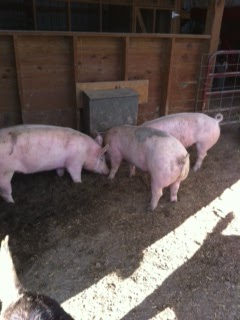Using a 1.5 pound roast from Whole Foods, I considered a complex marinade to start with, but then thought that maybe going with something simple was a better plan. So once I'd let the meat rise to room temperature, all I did to prepare this was to brush it with olive oil, and season it with salt, pepper and garlic.
Then to seal in the flavor, I seared it in a frying pan - I used as couple of ounces of bourbon here for that step in the process. I'm not sure that I noticed a strong bourbon flavor later when we were eating...I used Maker's Mark, a blend, instead of a favorite like Elijah Craig or Snob Creek.
After the browning, I moved the loin to the grill, where the coals were already white and ready. While the grill temp said 450+ degrees, I used an indirect method, hoping I had the loins in an area where the temp was more like 350 or so. I let them roast unmolested for about 40 minutes, and used the meat thermometer to see how things were going at that point.
The only grill opening I did during this phase was to toss in some hickory chips, which I used this time instead of gathering up some sticks and twigs from around the Hawksbill Cabin property - we've got several hickories back in the wood lot, and I do hope to stockpile from them eventually.
Finally, the meat thermometer read 160, and I moved the loins over to the coal side. I wanted to get some grill marks on them and bring them up to 165 to finish them. Once they were done, we served them up with some asparagus, and a mix root vegetable side dish, both of which were prepared in foil packs on the grill.
Three photos below show various stages of cooking, and the finished product. I'll definitely do this again, maybe doing the finishing touches at around 155 and taking the loin off the grill at 160 - they weren't overdone at 165, but the meat does continue to cook for a few minutes after they come off the grill. So removing them from the heat a few minutes earlier isn't going to hurt anything.


















































